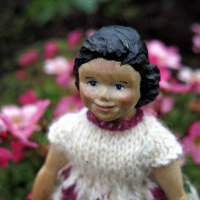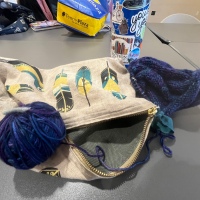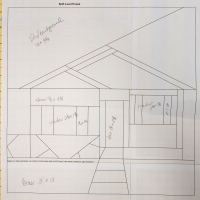Values Clarification
The artistic kind, not the money or morals kind. 🙂
I was watching a Quilting Arts video from Season 2, and quilter Katie Pasquini Masopust was saying that she stores her fabrics by color AND within each color, in seven value groups. Her message was that many quilters make a mistake by working only in the mid range of values, missing the lightest lights and darkest darks.
I would think it would depend on your purposes. Classic red-and-white quilts or indigo-and-white coverlets surely don’t need a wider range of values, and old quilts in faded pastels are so comforting and calming. But I tend to use a lot of contrast in my quilts, so analyzing them for value range was an interesting idea to me. I also wanted to test myself to see if color and value instincts are as good as I like to think they are!
(I worked in Adobe® Photoshop® Elements because I’m familiar with it, but I was looking at that free GIMP graphic editing software on line and I think it has all the tools you would need if you decide to try this on your own photos.)
First I made myself a little mock paint chip card, by just drawing 7 rectangles in a column.
Then I opened up one of my quilt photos in the same screen as the sample paint chip card.
Then I used the color picker tool (it looks like an eye dropper). Clicking it on a spot in the photo magically selects that exact color, and makes it the foreground color. So I decided which fabric in the quilt was the lightest and clicked on it.
Then I changed to the fill tool (it looks like a pouring paint bucket), and filled the top rectangle.
I went back to the color picker, chose a fabric that looked a little deeper in value to me, clicked to sample the color, and filled the next rectangle.
Once all seven rectangles were filled with a color, I merged them into one image, so I could convert it to black and white. This showed me what the relative values of the colors actually were. Here are the results I got from the butterfly quilt in the screen shot above.

Colors picked from the butterfly quilt are converted to black and white to show the range of values.
You can see that what I thought were seven different values, are really only five. The gold, orange, and light plum color are all very close in value. (It was also very interesting to me that colors that I saw as white and pale yellow, sampled as pale blue and a muted greeny-yellow.)

My first attempt to gauge the colors by value. The B/W side shows that some of the brighter colors are darker than I thought. I think it’s common for us to believe that more saturated colors are actually lighter than they are.
It may look like a lot of those mid-range grays are the exact same value, but on the computer, as I clicked on each one with the color picker, I could see a definite value change from one sample to the next.
Next I decided to try one of those old tops that I think of as faded, with little range of value. But this quilt definitely has “light lights” and a few “dark darks.”

Again, here the colors are arranged to better reflect their values. I wasn’t TOO far off on my first try.
Another, less computerish, way to do this would be to take black and white photos of your quilts, and then use one of those value cards from the art supply store to see what range of values you had worked into the piece. I tried converting my photo into black and white first, and then choosing the values with the color picker, but for me it was better to work with the colors first, and then let the computer do the B/W conversion.
I could see using this method with a quilt that was still in the design stage, to be sure that I didn’t have just a few either very light or very dark pieces drawing too much attention away from the rest of the quilt. But I don’t think I will ever be too concerned about using an exact number of values. What do you think? Do you think a good range of values helps make a more successful textile?





















Great exposition of this. Generally I think a range of values is important, if only because we have differences in what we see/interpret. A range allows the widest ability for that interpretation. But I have made quilts in a narrow range that were disappointing and quilts in a relatively narrow range that were fabulous. There are MANY design elements and principles that contribute to success — color and value, balance/proportion, size/shape, line, movement, unity… Value is just one. Don’t focus on one to the detriment of the others.
So… “Do you think a good range of values helps make a more successful textile?” Yes. Do I think it is the most important characteristic? No. Not unless we do the all-else-equal test, but then it still isn’t the most important characteristic, because if everything else is equal (all squares the same size, for example, with rigid patterning, all the same color but in different values…) it will just be BORING!!! 🙂
Again, this was a really good demonstration. Thanks for sharing.
I’m glad you liked it.
I think of all the art elements I tend to focus most on color and variety, in quilting at least – I love a random, improvised look. But since I started as a weaver, I am just as happy with textiles that are just one value, or have very subtle value differences provided by texture shadows. Can you imagine if every textile in a room had seven levels of value? It would be pretty busy!
Maybe I’ll create a room like that in Photoshop one of these days.
I don’t think I will do any changing of the way I arrange/choose fabric colors/prints for a pattern as I do agree with Melanie that there are more factors to be considered and, if I like it and it’s for me, then all is good. I have always been fascinated by comparisons like this!
Ya, I really enjoy working instinctively and just pulling out what “the quilt wants” without doing a whole lot of analysis. But I think I will give it a little more consideration now than I did before!
As I’ve become more aware of the various design elements/principles, I have changed my choices, though probably only marginally. And I am more analytical now than ever. Is that good or bad?? Not sure, but I do think my work is getting better all the time, on average.
I love the way your brain works! This analysis, which seems to have been motivated more by curiosity than any felt need to change your own approach, is fascinating. I think understanding value just gives us one more bit of information in our tool kit, one more way of achieving the “look” we are aiming for. Cool stuff!
I love to play around with ideas! I am sure they will all come together in an outstanding body of work someday – I am planning to have a career like Grandma Moses and start late! 🙂
You had me going there for a second re: values. Color/shade/tint values have caused much head scratching among quilters. Joen Wolfrom has written a book about color values. You can find a values card prepared by Leni Wiener at her website http://leniwiener.com/art-quilters-value-card/. She makes pictorial quilts from photos, so value is important for the look she wants. I do think it’s helpful to think beyond the middle range of value most quilters work with. I’ve seen many quilts that just look flat because all the values were the same. When I work from a photo I print out a gray scale copy of it to help me with value. Obviously value works in conjunction with warm/cool, etc., but I think the hardest part of value to grasp is that it’s relative. One fabric can be a light, medium, or dark, depending on the company it keeps.
That is so true about the relative values. I think that’s why I like the quilt you’re working on so much, especially with the random piecing – value variation within the two main color schemes. It makes it so rich.
Also, for this exercise, I didn’t bother to make sure the colors in the picture were well-lit or accurate – I just wanted to see if I did have a good range of value, AND if the older quilts that I love fit that profile too. It would also be fun to see what proportion of each value is in a quilt. I think I tend to have a lot of mid range with just hits of the really bold darks and lights, but it would be interesting to take a look at it.
Interesting and fascinating analysis…. I’ll have to agree though with some of the other posts, in that I don’t think I will change my way of choosing my fabrics. A good tool to have is a Red Ruby Beholder or the red glasses; they really work at identifying fabric values/colors, etc. Good post and brought about some interesting ideas.
I am glad you liked it. I just saw the tip about using a red filter in another art book somewhere; I will have to try that!
This is all Greek to me, but I think you have a fabulous eye for color and how to mix it. You make beautiful quilts.
Well, you are right – I did not think about doing a quick explanation for people that are not that experienced in the visual arts, and I am a former teacher so I should have. But for you I think I can do a translation to “writer-speak.” 🙂
Think about your Susan Hunter books. Throughout the book you describe what she’s wearing, eating, driving, and what her surroundings are like. Those are like the colors in an art piece, they’re what give your reader a visual picture. BUT underneath all that, there is some kind of emotion in every scene, and those are like the values, the “shades of gray” if you will. If every scene had the exact same emotion, the book would be pretty boring. You have to have some contrast – some light and happy moments, and a few dark and scary moments, to give interest to the book.
So on one of your re-reads of your manuscript, you could go through just looking for the tone of the emotions – “happy, happy, bored, ecstatic, scared out of her skin”, etc. to see if you liked the balance, or if you think you need more mood contrast somewhere.
The quilter I saw said that you need seven values to have a successful art quilt, and I was working through that idea to see if I thought it was true for me. Like if someone said you need seven emotional levels to have a successful book – do you? Is that what your aim is and what your readers want?
This is probably way more of a reply than you expected, but I was thinking about it all night! 🙂